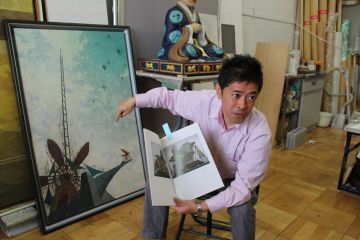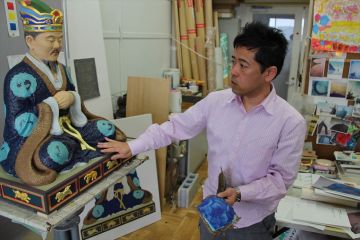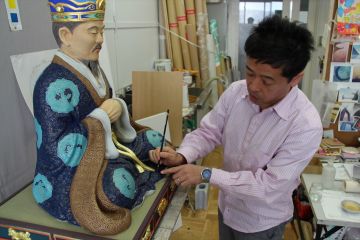TSUKUBA FUTURE
#039 From Classical to Avant-garde—Pursuing Free Nihonga (Japanese-style Paintings)
Associate Professor HODOZUKA Toshiaki, Faculty of Art and Design

The category of nihonga (Japanese-style painting) arose within art in the Meiji Period, and is therefore a surprisingly recent development. At this time, a culture of oil painting was imported from the West, and to distinguish from that, the various genres of painting which previously existed in Japan came to be collectively labeled nihonga. The world of nihonga has a strong image of classical art-forms such as black ink painting, screen painting, and ukiyoe, but actually the category allows free ideas and various forms of expression.
Prof. Hodozuka was a high school student when he first encountered nihonga. He primarily studied Western painting and sculpture at an arts high school, but when he visited a museum where his teacher's works were being exhibited, he looked in at a show of nihonga titled "Sogaten" (an exhibition by the Soga-kai Association of Japanese Painting) which was being held at the same time. The pictures differed somewhat from the image he had of typical nihonga, and he was surprised by the fact that the media, expression and subject matter were very free. However, there was no nihonga course at the University of Tsukuba at that time. In any case, he had entered the University of Tsukuba with the intention of studying a wide range of arts including Western painting and sculpture. Fortunately for him, before he decided on a final major, a new nihonga course was established. This revived his previous interest, and he decided to take the course.
He was very interested in nihonga expressed with free ideas, employing materials and techniques he had never used before. Prof. Hodozuka has continued his productive activities, using as a theme mental images of landscapes combining fragments of his own experiences and memories. Each of the depicted motifs—aircraft, insects, sky, etc.s—actually exists, but the overall composition is a "location which doesn't exist anywhere." He says that the natural landscapes he played in as a child have been developed and replaced by artificial structures, and the associated sense of loss and excitement has been a formative experience that serves as inspiration.

Passionately describing the challenges of new painting media and techniques
Nihonga is a field of art created in Japan, as something different from Western painting. It is a category defined in opposition to oil painting, and thus there is no strict definition. However, one characteristic feature is that it uses mixtures of nikawa (natural glue) and pigments derived from natural materials such as seashells and stones. The pigments made by crushing hard materials have a rough, granular texture, and even with the same material, color varies depending on granule size. Washi (Japanese paper) and silk may be used as support/base media. Today, artificial materials are also frequently used, and differences in the media have given rise to techniques unique to nihonga. Prof. Hodozuka is pursuing a technique characteristic of nihonga, called "urazaishiki" (back coloring) in which paints are allowed to soak in from the back side of the support medium. This method has the unique feature that it enables dream-like expression of spaces such as the sky through a bleeding effect unique to washi.
In addition to research activities carried out through his own works, Prof. Hodozuka is researching reproduction and restoration techniques for paintings and sculptures from the Edo Period. This work began when a large number of screen paintings, scrolls and other works from the Kano school were discovered in the year 2000 in the University of Tsukuba Library. When these were investigated by Prof. Masahiko Moriya, who specializes in Japanese art history, they were determined to have come from Yushima Seido, which can be regarded as the starting point of the University of Tsukuba and the Tokyo Normal School. A research project for reproducing Confucian art in Japan—such as murals and images of Confucius destroyed by fire in the Great Kanto Earthquake of 1923—was launched by assembling researchers from areas such as art history, nihonga, sculpture, and computer graphics in a team led by Prof. Moriya. Within this project, Prof. Hodozuka is in charge of reproduction and coloring of murals and a sculpture of Confucius. For the sculpture of Confucius, a bronze figure was produced by Prof. Yoshiki Shibata, a specialist in carving and modeling, based on extant photos and documents, and Prof. Hodozuka reproduced the sculpture and colored it using that figure. The sculpture for color reproduction was made by taking a mold from the bronze figure using lacquer and cloth (a dry lacquer image). There must be no mistakes in coloration, and this first experience of working with the material of dry lacquer and applying color to a three-dimensional sculpture was stimulating for Prof. Hodozuka, not only as an artist, but also as a researcher. Based on the small number of remaining documents, he began with preparatory tasks such as selection of paint materials and analysis of the patterns drawn on the clothing, and after two years of trial and error, he finally completed the work as ready for unveiling to the public. It was decided to hold a special exhibit showcasing the results of this reproduction research, with this sculpture of Confucius as the centerpiece, at the University Library and University Hall. This work of reviving the past origins of the University of Tsukuba was a research result achievable only through cooperation between various artistic fields within the university. Prof. Hodozuka also plans to take up the challenge of reproducing and coloring a life-size seated image of Confucius.
In continuing his creative activities, education and research at the university, Prof. Hodozuka is always conscious of the status of art as a subject of research, and of art and artists within society. Artistic works may be visible to the eye and easy to present, but it is difficult to make quantitative evaluations or achieve clear-cut results. Therefore, he sets himself to always presenting his finished works at exhibitions and other venues, and strives to clearly communicate with the public about his work. The supportive responses and honest reactions which he cannot obtain from the comments of his academic colleagues are very helpful. The process of making artistic works is an extremely inward-looking activity, but Prof. Hodozuka says that every aspect of the process is a creative activity, including this type of communication with exhibition goers. Prof. Hodozuka's creative impulse will continue to burn strong in the field of modern nihonga, with his sense for extracting impressive landscapes from daily life, his drive to pioneer new techniques and forms of expression, the inspiration he obtains from classic works, and the significance of painting media that he learns from reproduction and restoration work.

The professor holding a scrap of dry lacquer in his left hand

The professor reproducing the color of the sculpture of Confucius
Article by Science Communicator at the Office of Public Relations


